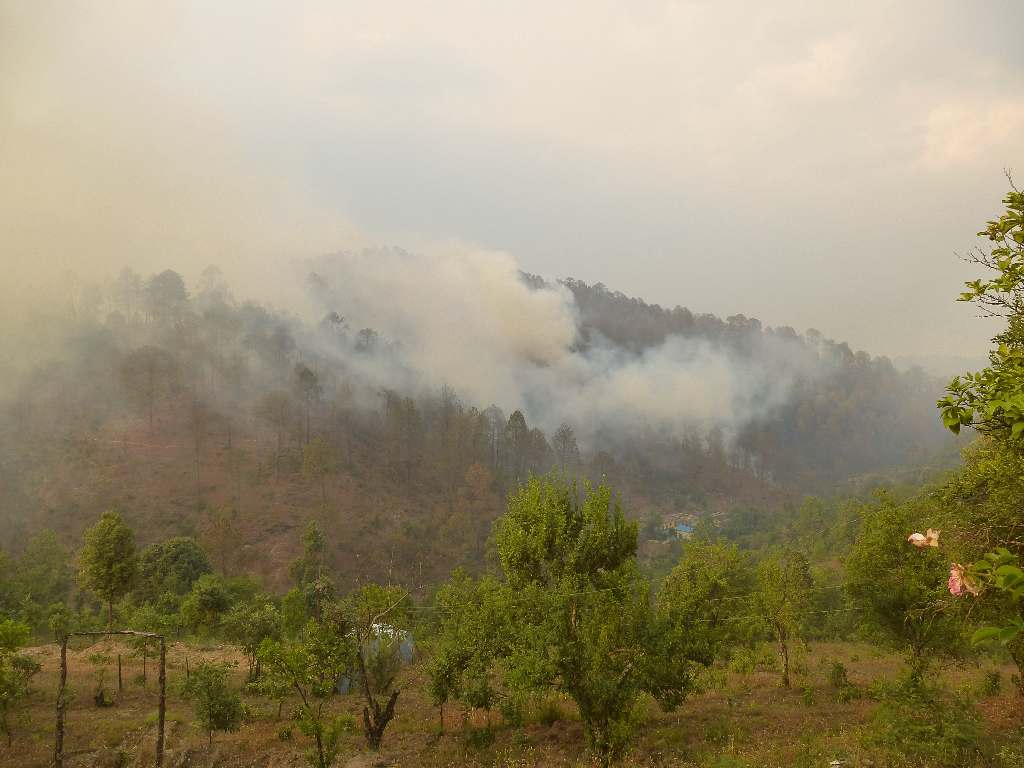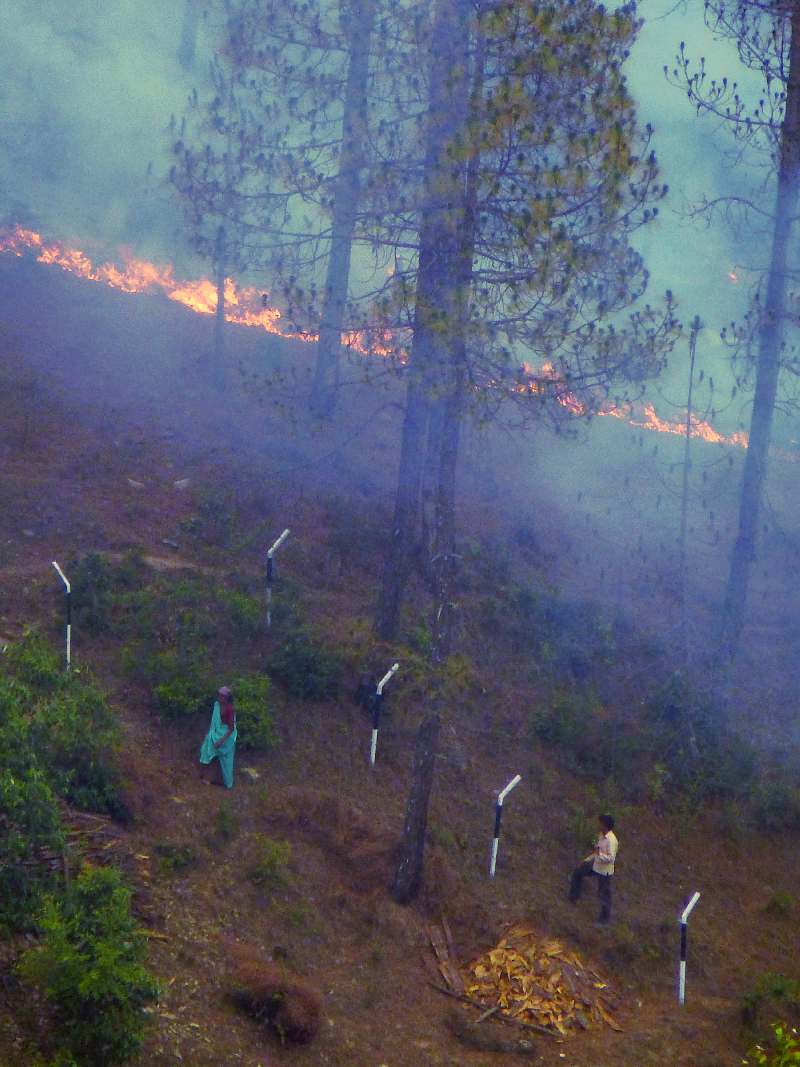Forest fires occur with distressing regularity in the Himalayan states in the summer. This article presents some information of the scale of forest fires in Uttarakhand, and a first-hand account of their impacts.

Our house lies almost at the bottom of a narrow valley. If I climb to the top of the Northern ridge, I see a broad plain ringed by mountains, and beyond them, the High Himalaya. The city directly in front is Almora. Both behind me and as far as I can see, lies forest.
To the lay person, the forests of Uttarakhand can be divided into mixed, deciduous, or coniferous. The coniferous forests are largely composed of pine, while the deciduous are dominated by oak and rhododendron. The mixed forests have both deciduous and coniferous trees in varying proportions. Forests enable rural life in the state. Green oak leaves for fodder, oak leaf litter for compost, pine litter for bedding animals and packing fruit, and wood from both for the kitchen fire, are needed to run a rural household. Added to these are the ecological benefits of forests which include water recharge, and the economical benefits which include collection of pine sap.
But this view is seen indistinctly. A grey haze covers it all, and the High Himalaya are invisible. Large swathes of forest are black and dead. From several places rise plumes of grey-yellow smoke. I could be looking at a campsite, but these are not campfires. They resemble clouds, but are not so benign.
 In summer, however forests are vulnerable to fires that cause loss to life and property. Bone-dry leaf litter, lack of humidity, and high winds can convert a single spark into a raging fire.
In summer, however forests are vulnerable to fires that cause loss to life and property. Bone-dry leaf litter, lack of humidity, and high winds can convert a single spark into a raging fire.
On the third of June, the fires reached the ridges of the valley we live in. No matter what direction the wind blew in, it brought us the smell of smoke. The burning pine smells sweet, but it filled me with fear. That day, the fire was quenched. Or so we thought. Two days later, in the late afternoon, it flared up again and began creeping down the slope to our house.
Uttarakhand has been prone to forest fires with the worst fires occuring in 2004 which devastated 4,850 ha of forest (1). This year, around 1500 ha of forest land has been subjected to fire. Most fires are man-made, either unintentionally (by the casual flinging of a bidi) or intentionally (set to ensure growth of grass, but rapidly spiralling out of control). Once lit, these fires are difficult to put out. An under-staffed, under-equipped, and under-motivated Forest staff cannot do more than put in a token effort. Very few villagers volunteer for the hot, dangerous, and thankless job of putting them out.
'If only one man went from each household, we can put out the fire', claimed Ganesh, our neighbour and caretaker of the orchard we live in. Our household would not stay back. My husband grabbed a rake and ran towards the fire, with maybe 10 other men. This is not much, but more than is usual. That any volunteers turned up at all is due to the work put in by the team at Sonapani-a nearby resort- who by simply going out and putting out fires in other peoples backyards, have shamed the villagers into acting themselves. They turned up for this fire too.
This work is hard, but rendered even harder by a lack of equipment. The low-flying planes, the chemical extinguishers, the bulldozers to excavate firelines, none of these are available here. Even if they were, the terrain makes their utility doubtful. Here, people use branches torn off nearby leaves, rakes, bare hands, and determination. Branches with leaves on are used to beat out low fires and sparks. Rakes and bunches of twigs are used to clear leaf litter and check the approach of the fire.

The fire has now come down all the way into the valley, upto the very fences of the Sitla Water Pump. I watch as one man and a woman try to save the pump. The two houses across our home are immediately threatened. The residents begin to collect the firewood they have stacked in the forest and bring it in. The pine sap contractor rushes into the fire to save his tins. The goods that these people are risking injury to save speak more eloquently of hardship than a million spreadsheets. The firewood represents a summer's work- without it, the family will be hungry for the rest of the year. A few blackened, rusty, much-dented tin cans are a man's entire stock- if those are damaged, he is ruined.
Smouldering low fires are common enough; in pine forests these climb up the trees to form a wall of fire that can potentially leap across streams and firelines.
The fire is gradually slowing down when the cruel wind picks up. Instantly, two pine trees burst into flame. I hear shouts from where the men have gone to work and am afraid. The work of the last four hours has been undone by a gust of wind. The fire is again raging now. It crosses the boundary we had hoped would contain it- one of the two tiny streams that flow down the mountain. It moves towards the houses. I try to remember how wide the stream at the bottom of the valley was when I saw it last. I had crossed it without getting my feet wet. It will not check this fire. My husband texts me. The fire is no longer one that can be contained. The men are all safe, but disheartened. They are coming back.
The fires are usually slow enough to not cause harm to life. This year, due to the winds and the prolonged dry spell, the situation is different. One woman has been killed and three injured due to forest fires (2).
The volunteers group at our house to drink water and pull thorns from their hands. They were surrounded by fire when the wind picked up, and only escaped by jumping down the slope. They cheerfully joke with me about the clumsy way in which they scattered. I am petrified. As they leave, they tell us to keep a watch on the fire. We are to call them if the fire starts climbing up this slope, they say, no matter how late it is.

The forest department claims to be fighting fires with state of the art technology (3). However, the fact remains that using satellite mapping has little or no impact on a fire in a forest away from the road. Fires, ultimately, need to be fought by the villagers. So far, it is being done only in remarkable circumstances. The Forest Department is budget strapped, with the state administration allocating Rs 21 Lakhs to it this year. A budget healthy enough to provide villagers with basic equipment and training will help. Far more useful will be a restructuring of the management of the forests in such a way as to allow locals more access and ownership. The 1151 crew stations spread across the state are not sufficient to watch the thousands of fires that burn their way through the mountains.
As we have dinner, we look out at the fire. With night, the fire has assumed a sinister appearance. The flames are visible now, and we watch a long ribbon of fire move across the mountain. Secondary fires are starting up on the slopes. Fanned by the wind, areas that we had thought were extinguished glow red again. We start talking of what we need to do if- when- it crosses the stream. Magically, as we talk, there is a coolness in the wind. We look amazed at each other as the first few drops fall. The drops turn into a real storm and we hear cheering from the houses. All that night it continues to rain. We stand and watch the fires slowly die down. The next morning, the flames are out but the forest continues to smoke.
Besides the immediate damage to the environment and to property, fires have a long-standing impact. Pine is more resilient to fire than oak is, the villagers tell me. After a fire, a mixed forest tends to recover with pine as the dominant species. With the loss of biomass, wildlife moves into the farms for food, increasing human-animal conflicts.
Human-human conflicts are on the increase too. The fire has wiped out all fodder in the area. One neighbour's cattle have strayed into the other neighbour's fields and eaten his painstakingly tended crop. Rumours are rife about the start of the fire. It was set on purpose, says one person darkly, to make us sell our land. It was set for revenge, says another. Nature will punish whoever it was, they say. The monsoon needs to come soon, we agree.
References:
1 'About 30,000 hectares forest area affected by forest fire', Euttaranchal, 05 June 2012
2 'Woman killed in Uttarakhand forest fire, Times of India, 23 May 2012
3 'Forest fires in Uttarakhand on the rise, International Reporter, 01 June 2012
/articles/burning-mountains-first-hand-account-forest-fires-summer-uttarakhand